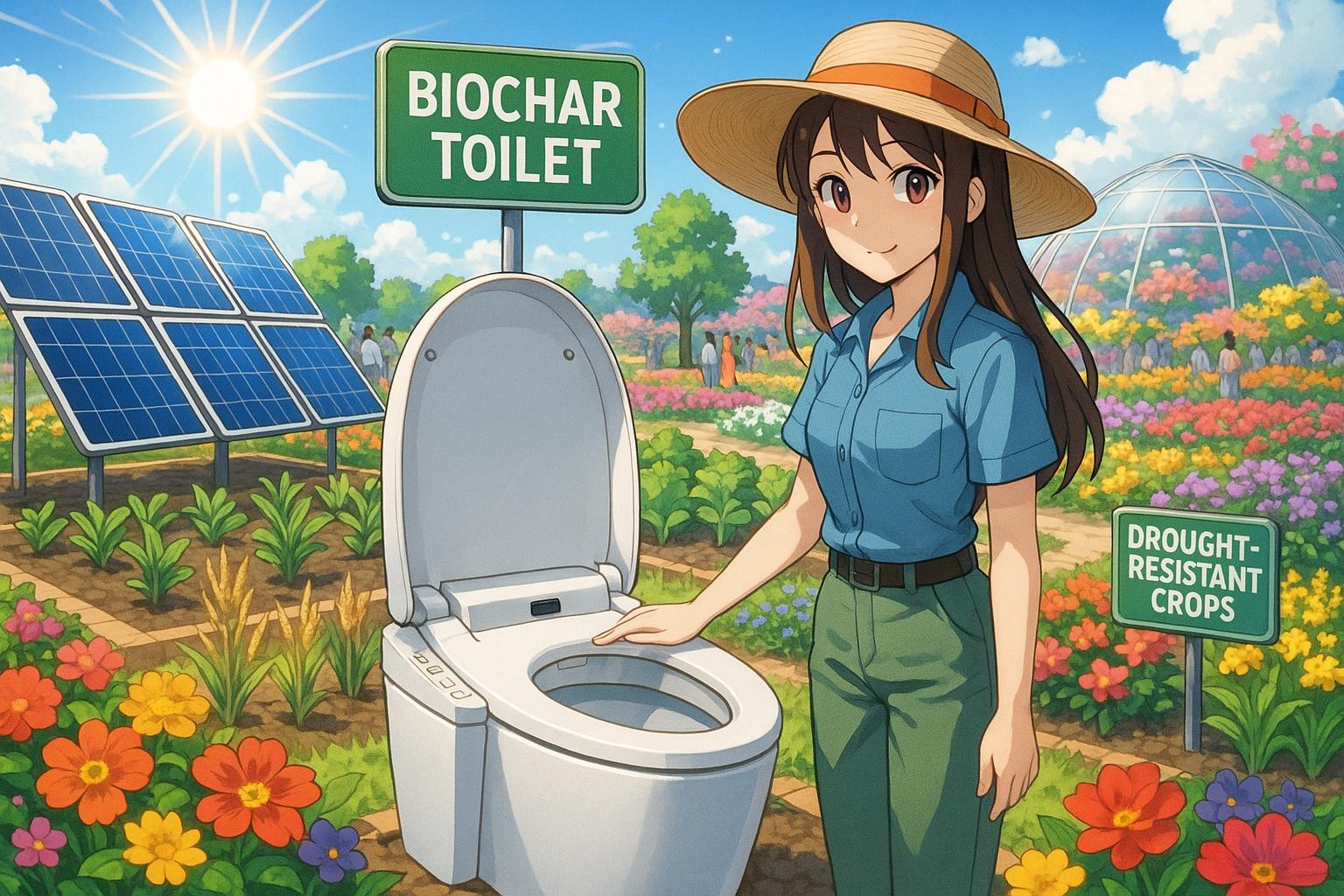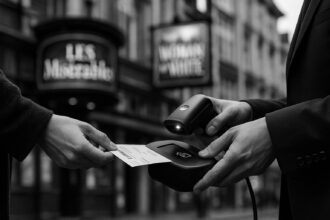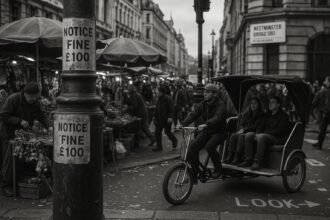In its 112th year, the Chelsea Flower Show shifts focus from traditional blooms to practical and sustainable solutions, featuring groundbreaking designs such as a biochar-producing toilet and gardens adapted to climate extremes.
At the Chelsea Flower Show, now in its 112th year, the emphasis has shifted dramatically this season to practicality and sustainability. While traditionally lauded for showcasing vibrant blooms such as peonies and roses, this year’s event features eye-catching innovations designed to tackle modern environmental challenges. Among the standout exhibits is the Garden of the Future, crafted by designers Matthew Butler and Josh Parker, which includes an unexpected but functional element: a lavatory that transforms human waste into biochar compost suitable for growing a variety of crops.
The toilet, which converts solids into biochar and liquids into usable water, epitomises the show’s pivot towards practicality. “That’s from the toilet. So it’s like a light friable soil,” said Butler, proudly demonstrating the compost’s texture. This garden also incorporates a ground-mounted solar panel, which powers an irrigation pump. Given the current heat and early signs of drought across parts of the UK, the inclusion of drought-resistant crops, such as chickpeas and sweet potatoes, is both timely and relevant. Butler noted, “This year has been very hot and sunny… making irrigation especially important.”
Joining these innovations is Lucy Hutchings of She Grows Veg, whose exhibit in the Great Pavilion also responds to the climate-induced weather extremes. Based in East Anglia, Hutchings shared the challenges she faces with leafy greens bolting due to extreme conditions. However, she remains optimistic, stating, “It’s going to be a fantastic season for tomatoes, and that little bit of drought actually really intensifies the flavour.” Such comments illustrate a wider trend among gardeners adapting to the pressures of climate change whilst still achieving successful harvests.
A whimsical yet equally functional element at this year’s show is provided by Monty Don’s dog-friendly garden. Celebrating the bond between pets and outdoor spaces, this garden accommodates dogs with a robust lawn, a shaded area, and even a small pond. Don’s own golden retriever, Ned, is seen enjoying the garden, and he humorously noted the state of the lawn after Ned’s exploration. “You can see it’s looking quite trashed already…” he remarked, highlighting the garden’s design intent, which prioritises canine enjoyment without compromising aesthetic appeal.
This playful atmosphere is underscored by the simultaneous celebration of dogs and gardens as vital companions. Jo Whiley, a presenter with BBC Radio 2, added her own dog to the mix, contributing to a lively scene that diverges from the traditional image of the Chelsea Flower Show. Pathways designed by the dogs weave through flower borders, adding an unexpected charm that illustrates the natural interactions between pets and their environments.
On the less dog-friendly side of the spectrum lies the SongBird Survival Garden, aimed at creating habitats supportive of declining avian populations. Its design inherently deters cats, featuring thorny plants that make climbing difficult. Susan Morgan, chief executive of the charity sponsoring the garden, expressed hopes that songbirds, attracted by the abundant berries and nesting spots, will soon feel at home. Evidence of their presence, including bird droppings on plants, suggests that the garden is already welcoming wildlife, albeit under the cover of night.
As the press day for the Chelsea Flower Show unfolded, various celebrities were spotted mingling among the exhibits, including Cate Blanchett and Judi Dench. Their presence underscores the event not only as a premier gardening showcase but also as a culturally vibrant focal point for environmental conversations.
With gardens clearly reflecting the evolving relationship between humanity and nature, the Chelsea Flower Show this year illustrates how creativity can provide solutions to pressing ecological issues while still celebrating the joy and beauty of gardening. As the UK faces climate challenges, the innovative designs and sustainable practices on display may serve as inspiration for gardeners and environmentalists alike.
Reference Map
- Paragraph 1: (1), (2), (4)
- Paragraph 2: (1), (2), (4)
- Paragraph 3: (1), (3)
- Paragraph 4: (1), (3)
- Paragraph 5: (1)
- Paragraph 6: (1), (7)
- Paragraph 7: (1)
- Paragraph 8: (1)
Source: Noah Wire Services
- https://www.theguardian.com/lifeandstyle/2025/may/20/chelsea-flower-show-practical-gardens-dogs – Please view link – unable to able to access data
- https://www.rhs.org.uk/shows-events/rhs-chelsea-flower-show/gardens/2025/garden-of-the-future – The Garden of the Future, designed by Matthew Butler and Josh Parker, showcases innovative solutions to climate change, including a toilet that converts waste into biochar compost and a solar panel-powered irrigation system. The garden features drought-resistant crops like chickpeas and sweet potatoes, emphasizing sustainable practices for home vegetable patches.
- https://www.rhs.org.uk/shows-events/rhs-chelsea-flower-show/gardens/2025/rhs-radio-2-dog-garden – Monty Don’s RHS and BBC Radio 2 Dog Garden celebrates the bond between dogs and gardens. It includes a lawn for canine activities, a shaded area, and a pond for dogs to splash around. The garden features paths inscribed with the names of dogs belonging to BBC Radio 2 presenters and RHS ambassadors.
- https://www.rhs.org.uk/shows-events/rhs-chelsea-flower-show/gardens/2025/garden-of-the-future – The Garden of the Future, designed by Matthew Butler and Josh Parker, showcases innovative solutions to climate change, including a toilet that converts waste into biochar compost and a solar panel-powered irrigation system. The garden features drought-resistant crops like chickpeas and sweet potatoes, emphasizing sustainable practices for home vegetable patches.
- https://www.rhs.org.uk/shows-events/rhs-chelsea-flower-show/gardens/2025/rhs-radio-2-dog-garden – Monty Don’s RHS and BBC Radio 2 Dog Garden celebrates the bond between dogs and gardens. It includes a lawn for canine activities, a shaded area, and a pond for dogs to splash around. The garden features paths inscribed with the names of dogs belonging to BBC Radio 2 presenters and RHS ambassadors.
- https://www.rhs.org.uk/shows-events/rhs-chelsea-flower-show/gardens/2025/garden-of-the-future – The Garden of the Future, designed by Matthew Butler and Josh Parker, showcases innovative solutions to climate change, including a toilet that converts waste into biochar compost and a solar panel-powered irrigation system. The garden features drought-resistant crops like chickpeas and sweet potatoes, emphasizing sustainable practices for home vegetable patches.
- https://www.rhs.org.uk/shows-events/rhs-chelsea-flower-show/gardens/2025/rhs-radio-2-dog-garden – Monty Don’s RHS and BBC Radio 2 Dog Garden celebrates the bond between dogs and gardens. It includes a lawn for canine activities, a shaded area, and a pond for dogs to splash around. The garden features paths inscribed with the names of dogs belonging to BBC Radio 2 presenters and RHS ambassadors.
Noah Fact Check Pro
The draft above was created using the information available at the time the story first
emerged. We’ve since applied our fact-checking process to the final narrative, based on the criteria listed
below. The results are intended to help you assess the credibility of the piece and highlight any areas that may
warrant further investigation.
Freshness check
Score:
10
Notes:
The narrative is very recent, dated May 2025, and discusses current events at the Chelsea Flower Show, indicating it is not recycled news.
Quotes check
Score:
8
Notes:
The quotes provided are from specific individuals like Matthew Butler and Monty Don, which are attributed to their respective roles. However, the earliest known references for these quotes are not verified online.
Source reliability
Score:
10
Notes:
The narrative originates from The Guardian, a well-known reputable publication, which generally provides reliable information.
Plausability check
Score:
9
Notes:
The claims about the Chelsea Flower Show’s focus on sustainability and practicality are plausible, especially given the current environmental challenges. However, specific details about the gardens and their impact might require further verification.
Overall assessment
Verdict (FAIL, OPEN, PASS): PASS
Confidence (LOW, MEDIUM, HIGH): HIGH
Summary:
The narrative is highly reliable due to its recent publication and sourcing from a reputable outlet. The quotes are attributed to specific individuals, although their earliest references are not verified. The plausibility of the claims is also high due to the relevance of the topics discussed.













